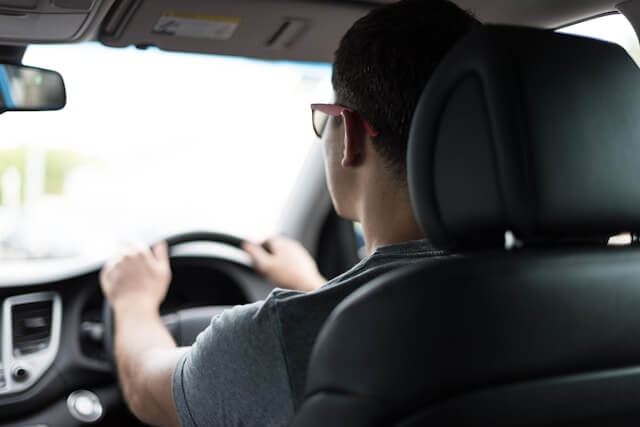7. Watch your speed
Obey posted speed limits. Not only is speeding dangerous for you and other drivers, cyclists and pedestrians, but speeding tickets issued by a police officer will lead to an increase in your car insurance premium and potential demerit points against your license. If you are constantly racking up speeding tickets, your insurance policy could be cancelled altogether.
Reducing your speed can also help you save on fuel. According to Natural Resources Canada, most vehicles are at their most efficient when travelling between 50 and 80 km/h. For example, at 100 km/h, your car uses 20% less fuel than at 120 km/h. On a 25 km trip, you would only save 2 minutes — is that really worth the 20% increase in fuel consumption?
8. Stay calm behind the wheel
It’s easy to get frustrated by poor behaviour from fellow drivers, like changing lanes without signalling, tailgating, and excessive speeding. Responding in kind or engaging in road rage can lead to accidents and potential violence, so stay calm and let the other motorist drive away.
9. Fasten your seatbelt
Seatbelts and safety seats for children are important mandatory safety features of your car. In 2021, 28.6% of driver fatalities involved people not wearing seatbelts. As a driver, you are responsible for your passengers buckling up. There are hefty fines for being pulled over for a seat belt infraction and your car insurance premium will suffer as a result.
10. Avoid distractions
Don’t be that person who’s putting on lipstick or brushing their hair while driving! As well, with all the technology in our lives, it can be tempting to want to look at your cell phone or similar device when you’re behind the wheel. Using an electronic device while driving is not only dangerous, but it can also bring heavy fines if you’re pulled over: in Ontario, a first offense carries a $615 fine, a 30-day driver’s license suspension and 6 demerit points.
If you have to take that call, find a safe place to pull over such as a parking lot or residential side street, or take care of your tasks before or after your time behind the wheel.
11. Don’t drink and drive
Alcohol (and drugs for that matter) impair your ability to drive, even after one drink. Taking the wheel while under the influence of drugs or alcohol endangers your life and the lives of others and exposes you to serious legal action.
Alcohol affects your ability to drive in many ways: it gives you a false sense of security, it diminishes your concentration, it slows your reaction time, it weakens your coordination, and it causes drowsiness.
You can be arrested if your blood alcohol concentration equals or exceeds 80 mg of alcohol per 100 ml of blood. In Quebec, the consequences of a first offence involve the immediate suspension of your license for 24 hours to 90 days and the immediate seizure and impoundment of your vehicle. In other provinces, there are also administrative penalties for even lower levels of blood alcohol.
If you have consumed alcohol or drugs and have any doubts about your ability to drive, err on the side of caution. Use a taxi, a ride-hailing service, or public transit. You can also have a friend or designated driver take you home or if you are visiting friends or relatives, you could spend the night at their place.
Commonly asked questions
If I get an automated ticket for running a red light, will my premium go up?
No, automated tickets do not affect your car insurance premium.
They also don’t add demerit points to your license and will not appear on your driving record. Just like with parking tickets, the reason for this is that there’s no way to confirm who was driving the vehicle at the time the camera recorded the infraction.
However, if you are pulled over by a police officer who gives you a ticket for failing to stop at a red light, it will impact your insurance, unless you successfully appeal the ticket.
Can I use my cell phone while I’m stopped at an intersection?
Many people erroneously think it’s okay to use their handheld devices when they are stopped at an intersection. Even though you’re not moving, you are still in the process of driving and need to be aware of other vehicles, pedestrians, and cyclists. Using a phone, even at a red light, constitutes distracted driving.
A police officer can issue you a citation for using your cell phone at a red light, as it constitutes a distraction. In Quebec, for example, a first offence for distracted driving carries a fine of $300–$600.
Will a speeding ticket issued by a police officer appear on my driving record?
Yes, unless you successfully appeal it. In Ontario, the infraction will stay on your driving record for 3 years from the date of conviction, which is the date upon which you pay your fine and acknowledge the infraction.
Want to learn more? Visit our Car insurance resource centre for dozens of helpful articles. Or, get an online car insurance quote in under 5 minutes and find out how affordable personalized coverage can be.
About the expert: Jil McIntosh
Jil McIntosh writes professionally about a variety of automotive subjects, and has contributed to such publications as Driving.ca, AutoTrader.ca, Automotive News Canada, Old Autos, Toronto Star Wheels, and more. A member of the Automobile Journalists Association of Canada (AJAC), she has won numerous awards for her writing, including Automotive Journalist of the Year.


